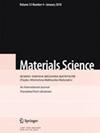通过在聚合物复合材料的复合氧化物中掺入钠离子改善微波介电性能
IF 0.7
4区 材料科学
Q4 MATERIALS SCIENCE, MULTIDISCIPLINARY
引用次数: 0
摘要
本研究的重点是复合氧化物填充环氧树脂、聚氨酯和硅橡胶复合材料的介电性能。具体来说,除了 Na0.5Bi0.5Mo0.5W0.5O4 和 Bi2Mo0.5W0.5O6,我们还研究了 (1-x) CaWO4-xNa2WO4(x = 0、0.2、0.4)的各种成分。我们通过固态反应精心合成了这些复杂的氧化物材料,并通过严格的 X 射线衍射 (XRD) 表征确认了它们的不同物相。然后,我们将这些复合氧化物与环氧树脂、聚氨酯和硅橡胶基质进行人工混合,制成了复合材料。我们的观察结果表明,复合氧化物填料的含量与介电特性(包括介电常数和介电损耗)直接相关。具体来说,在相应的聚合物基体中添加体积分数为 10% 的 (1-x) CaWO4-xNa2WO4 (x = 0, 0.4)、Na0.5Bi0.5Mo0.5W0.5O4 或 Bi2Mo0.5W0.5O6 填料可显著提高介电常数和损耗正切。三种复合材料配方的效果尤为明显:10% 0.4Na2WO4-0.6CaWO4 硅橡胶复合材料的介电常数(εr)为 2.0.4Na2WO4-0.6CaWO4 硅橡胶复合材料的介电常数 (εr)为 2.02 ´ 102,在 7.1 GHz 时的损耗正切 (tanδ) 为 -4.07 ´ 10-1;10 % Na0.5Bi0.5Mo0.5W0.5O4/epoxy 复合材料的介电常数为 1.37 ´ 102,在 7.1 GHz 时的损耗正切为 -6.43 ´ 10-1。这些结果表明这些复合材料适合广泛的微波技术应用,包括无线通信、雷达系统和各种微波设备。本文章由计算机程序翻译,如有差异,请以英文原文为准。
Improvement of Microwave Dielectric Properties by Impact of Sodium Ion Doping in Complex Oxides for Polymer Composites
The research presented in this study focuses on the dielectric properties of complex oxide-filled epoxy, polyurethane, and silicone rubber composites. Specifically, we investigated various compositions of (1-x) CaWO4-xNa2WO4 (x = 0, 0.2, 0.4), in addition to Na0.5Bi0.5Mo0.5W0.5O4 and Bi2Mo0.5W0.5O6. These complex oxide materials were meticulously synthesized through a solid-state reaction, and their distinct phases were confirmed via rigorous X-ray diffraction (XRD) characterization. We then proceeded to create the composites by manually blending these complex oxides with epoxy, polyurethane, and silicone rubber matrices. The central focus of the study was to examine the impact of varying volume fractions of the complex oxide fillers on the dielectric properties of the composites in the frequency range of 4 – 8 GHz.Our observations revealed a direct correlation between the content of the complex oxide filler and the dielectric properties, including the dielectric constant and dielectric loss. Specifically, the addition of 10 % by volume fraction of (1-x) CaWO4-xNa2WO4 (x = 0, 0.4), Na0.5Bi0.5Mo0.5W0.5O4, or Bi2Mo0.5W0.5O6 fillers to the respective polymer matrices led to a significant enhancement in both the dielectric constant and the loss tangent. Promising results were particularly evident in three composite formulations: the 10 % 0.4Na2WO4-0.6CaWO4/silicone rubber composite demonstrated a dielectric constant (εr) of 2.02 ´ 102 and a loss tangent (tanδ) of -4.07 ´ 10-1 at 7.1 GHz; the 10 % Na0.5Bi0.5Mo0.5W0.5O4/epoxy composite exhibited a dielectric constant of 1.37 ´ 102 and a loss tangent of -6.43 ´ 10-1 at 7.22 GHz; and the 10 % Bi2W0.5Mo0.5O6/polyurethane composite displayed favorable properties with a dielectric constant (ϵr) of 8.37x101 and a loss tangent (tanδ) of -3.4 ´ 10-1 at 7.12 GHz.These results suggest the suitability of these composite materials for a wide range of microwave technology applications, including wireless communication, radar systems, and various microwave devices.
求助全文
通过发布文献求助,成功后即可免费获取论文全文。
去求助
来源期刊

Materials Science
工程技术-材料科学:综合
CiteScore
1.60
自引率
44.40%
发文量
63
审稿时长
4-8 weeks
期刊介绍:
Materials Science reports on current research into such problems as cracking, fatigue and fracture, especially in active environments as well as corrosion and anticorrosion protection of structural metallic and polymer materials, and the development of new materials.
 求助内容:
求助内容: 应助结果提醒方式:
应助结果提醒方式:


